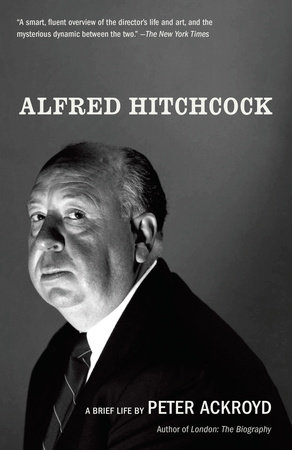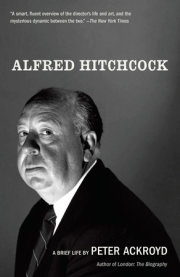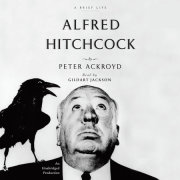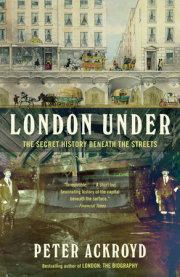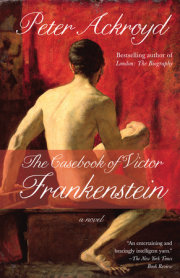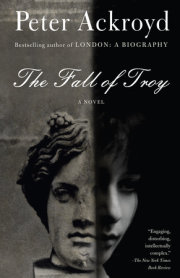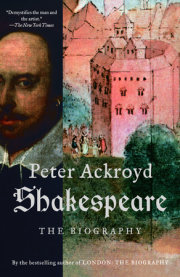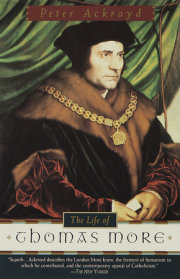1
the child who never cried
Alfred Hitchcock was born on 13 August 1899 on the floor above his father’s shop at 517 High Road, Leytonstone; Leytonstone was by the time of his birth a soft forgetful suburb, sweltering in summer and sullen in winter. It was marked by a sense of vacancy, deriving from the time when it was simply a hamlet on the Roman road to London. It was situated five miles to the northeast of the city, and at the time of Hitchcock’s birth was still nominally part of Essex, but the vast roar of London was coming ever closer. In 1856 the Great Eastern Railway arrived and Leytonstone soon became a “dormitory town” filled with the modestly affluent who made their way each morning into the City and its environs.
William Hitchcock was a greengrocer, selling everything from cabbages to turnips. It was as busy as any other high road, with horses and carts and carriages passing incessantly; the scent of bananas ripening, and the musty dusty odour of potatoes, were mingled with the keener stench of horse dung. The pervasive smell of manure was in fact only alleviated by the arrival of the electric tram in 1906, an event that Hitchcock vividly remembered. A photograph was taken of him and his father outside the family business on what looks to be the recently established Empire Day; he is astride a horse, no doubt the one that brought the produce from Covent Garden market. William Hitchcock was a successful merchant, whose business soon expanded, and Hitchcock told one biographer that “I remember my father going to work in a dark suit with a very white starched shirt and a dark tie.” In this, at least, the son came to resemble the father. William Hitchcock was also a highly nervous man, who suffered from various neuralgic conditions such as skin lesions.
Emma Hitchcock was by all accounts also smartly dressed, meticulous and dignified; like most lower-middle-class housewives, Hitchcock’s mother took great delight in cleaning and polishing the appurtenances of the home. She was also adept at preparing family meals, a process she immensely enjoyed.
Hitchcock claimed he was told that, as a baby and small child, he never cried. Yet he also adverted to his terror when, as an infant in the cradle, a female relative put her face too close to his own and uttered baby noises. He also remarked that when a baby is about three months of age, the mother will try and scare it; it is an experience that supposedly both of them enjoy. On another occasion he recalled his mother saying “Boo!” at him when he was six months old. Even if he never cried, he was not devoid of fear.
He had an older brother, called William after his father, and an older sister, Ellen, known as “Nellie”; but they seem to have left no lasting impression on his life. The Hitchcocks were a deeply Catholic family, with three of his grandparents Irish Catholics amongst whom religion was instinctive and almost primordial. His father called him “my lamb without a spot,” and Hitchcock himself remembered standing at the foot of his mother’s bed at the end of the day to recite his adventures or misadventures; it was a form of familial confession.
The family moved down to Limehouse when Hitchcock was six or seven. Limehouse had become an integral aspect of the East End of London by the latter part of the seventeenth century, when it harboured a population of some 7,000 with close connections to the river. These were the men and boys who went down to the sea in ships. In the eighteenth and nineteenth centuries it was one of the most important centres for shipbuilding in London. So now the boy can truly be claimed as a Londoner and even, by the common consent of the time, a cockney. A Chinese colony had moved into Limehouse twenty years before his own arrival, and provided another distinctive colour in Hitchcock’s boyhood world.
William Hitchcock had expanded his business by purchasing two fishmonger shops in the aptly named Salmon Lane; the family lived above one of them, at number 175. The lane was a few yards north of Limehouse Basin and the Thames, so the penetrating smell of fish was compounded by the more settled odour of the murky river. In 1905, just before the Hitchcock family’s arrival in the neighbourhood, Henry James wrote in English Hours that by the Thames a “damp-looking dirty blackness is the universal tone. The river is almost black, and is covered with black barges; above the black house-tops, from among the far-stretching docks and basins, rises a dusky wilderness of masts.”
Limehouse was a rough and raucous neighbourhood, the very essence of what was known as “the stinking pile” of East London. The river Lea, which runs through it, had for centuries been the site of industries banished to the outskirts of the city, among them dye works and chemical works and glue factories. In an essay that the young Hitchcock devoured, “On Murder Considered as One of the Fine Arts,” Thomas De Quincey described the area in 1812 as “a most dangerous quarter,” a “perilous region” replete with “manifold ruffianism.” It had not changed a great deal by the time of Hitchcock’s arrival. It was a neighbourhood of small shops and houses standing a few feet back from the pavement, little plots of impoverished humanity. Most Londoners shunned the area. When Hitchcock was growing up here the public houses were open from early morning to half-past midnight, with a glass of gin or a half-pint of beer for a penny.
Hitchcock rarely alluded to this fusty frantic world in interviews, but it is manifest in his early English films where the street life of London emerges on to the screen with its music halls and its public houses, its picture palaces and its street markets, populated by the animated and quick-witted cockneys whom he knew so well.
As a boy he was called by his parents “Alfie” or “Fred” which, as soon as he reached mature years, he changed to “Hitch.” He was always reticent about his childhood, and his family, but he did manage to recall certain episodes. He enjoyed telling of the occasion when, for a minor misdemeanour, his father colluded with a local policeman to have him locked in a police cell for two or three minutes. The boy had returned late after one of his expeditions through London. The event is meant to “explain” his apparent lifelong fear of policemen as well as his obsessive interest in guilt and punishment. It is not at all clear, however, why William Hitchcock would arrange for his “lamb without a spot” to undergo what would be for a small boy a terrifying ordeal. One caveat may be entered. Throughout his films vertical bars, parallel bars, and dark slashes of shadow become a familiar motif.
It is clear enough, however, that fear fell upon him in early life. He may have created the little symbolic drama of the father and the policeman, endlessly repeated to interviewers, as a litany to dispel darkness. Yet something already marked him out as a shuddering, shivering human being, afraid of judgement and punishment. Many interpretations and explanations for this have been adduced, from his relationship with his mother (never mentioned by him) to his Jesuitical education (always introduced by him). The sexual fantasies of his adult life were lavish and peculiar and, from the evidence of his films, he enjoyed devising the rape and murder of women. He said that he always followed the advice of the French playwright Victorien Sardou, to “torture the women!” So it is possible that even as a child he harboured desires and instincts that could not be admitted. Hence the fear of the world that became his familiar characteristic. He was afraid of crossing the floor of the studio canteen in case someone approached him. He fled disorder. He arranged his life as if it were a military campaign, although it is not clear who or what the enemy might be.
He had a horror of life that could only be assuaged by his imagination. And, essentially, he never changed. The fears and obsessions of his childhood remained with him until the end of his life. In certain respects, he was always a child. His absorption in the plots of his films, imagining a sequence of powerful scenes, parallels the fantasies of attack and private calamity on which he obsessively dwelled. That, at least, is part of his story.
. . .
From an early age he seems to have been obsessed with travel and transportation; perhaps in fantasy he wanted, somehow, to get away and to be anywhere other than Limehouse, the East End and the riverine world. He collected maps and timetables, tickets and schedules, and all the other paraphernalia of journeying; he pinned a map on his bedroom wall and with small flags charted the progress of ocean-going vessels according to the latest information he had read in Lloyd’s List; he memorised the stations along the routes of the Orient Express and the Trans-Siberian Railway with the help of Cook’s Continental Time Tables. Even by reciting the names of destinations, and contemplating the portions of blue sea upon the map, he was transported in imagination. Yet at the same time he kept a meticulous record of the hours of departure and arrival, so that all his tickets and schedules were arranged in precise fashion. Even as a child he kept tight control over his fantasies. On his office desk, in later life, he kept a European train schedule.
But he was not only an armchair traveller. He said that by the age of eight he had travelled on every route, from beginning to end, of the London General Omnibus Company. Its maps advertised journeys “by motor and horse.” He was a passenger on the London Tilbury and Southend Railway that stretched from Fenchurch Street to Shoeburyness. Here lies the origin of that fascination with boats and trains which begins in his early silent films and continues through Strangers on a Train and beyond. He kept precise timing on his film sets and, as he said in The Stage in 1936, “I have to know where I am going every second of the time.” This is the creed of the nervous traveller.
. . .
His early schooling was that of an orthodox Catholic. At a young age Hitchcock was enrolled as an altar boy, and seems to have enjoyed the ritual that accompanied the office. He loved the sweet sense of guilt relieved, of bells and incense announcing a sacred sense of the world. At the age of nine he attended as a boarder the Salesian College in Surrey Lane, Battersea, over the river; it was established by the order of the Salesians of Don Bosco, with a mission to educate “the children of the urban poor” and “aspiring working class.” Hitchcock lasted only a week, no doubt horrified by the regime of a boarding school and the enforced absence of his family. He was then enrolled at a local convent school on the East India Dock Road, Howrah House, run by the Sisters of the Faithful Companions of Jesus.
At the age of ten he moved to St. Ignatius College in Stamford Hill, a school run by Jesuits in the strict fashion of that order; the motto of Ignatius himself is popularly supposed to be “Give me the boy and I’ll give you the man.” Hitchcock’s pupil number was 343, and in the register of admissions he is named “Alfred Hitchcock, son of William Hitchcock, Fishmonger.”
He told an interviewer that he had learned from the Jesuits the virtues of order, control and precision; the Jesuits were well known for their ability to fabricate arguments on tortuous questions, and for turning equivocation into an art form. This may partly have come from their experience as hunted missionaries in Elizabethan England, when many were tortured in the Salt Tower of the Tower of London before being killed.
Hitchcock absorbed knowledge quickly and expeditiously, so the wide curriculum would not have presented any great difficulty to him. He was obliged to study Latin and mathematics, physics and English; the notable authors, such as Longfellow and Shakespeare, were memorised and recited on special occasions. He never came top of the class, but he usually earned a respectable third or fourth place. He did also gain a distinction in mathematics.
The routine itself was unchanging. The daily Mass was conducted, in Latin, at 8:45, and the boys genuflected to the Blessed Sacrament before making their way to class. Each classroom possessed its own altar dedicated to the Blessed Virgin Mary, in front of whose image were placed flowers and candles. The boys went to confession every Friday where their sins were revealed and absolved. A “retreat” of three days was ordained each year, during which time they meditated on the spiritual exercises of St. Ignatius and contemplated the seven deadly sins and the four last things. In an interview with the school newspaper, many years later, Hitchcock wrote that “a Catholic attitude was indoctrinated into me. After all, I was born a Catholic, I went to a Catholic school and I now have a conscience with lots of trials over belief.” What his training most firmly instilled in him, however, was a sacred rather than a secular view of the world where mystery and miracle are as important as logic and reason.
Of Irish Catholic stock he was always something of an “outsider,” at least in England. But, more importantly, a Catholic education instilled in him a powerful conscience together with a tremulous sense of guilt. He feared and hated the body. He felt unease with all bodily functions. After he went to the lavatory, he cleaned it so that it seemed as if no one had been there. His was always a life of the mind, isolated and apart.
The priests and brothers of St. Ignatius College also had a predilection for punishment, not unknown in that period in most London schools. It was not quite as hellish as Dotheboys Hall in Nicholas Nickleby, perhaps, but it was tough. Discipline was administered with the aid of a hard rubber strap; three strokes would render the hand numb, so a sentence of twelve strokes had to be extended over two days. In a refinement of anxiety the boys themselves could choose the time for the ordeal; most of them of course put it off to the end of the day, so that their anticipation of pain naturally increased. It is not known how often Hitchcock received this penalty, but it is likely to have been rare. He had a preternatural fear of authority of every kind, and the black-robed Jesuit no doubt instilled nervous terror. He explained once that “I was terrified of the police, of the Jesuit fathers, of physical punishment, of a lot of things. This is the root of my work.” The remark has a further application. He once said that “I spent three years studying with the Jesuits. They used to terrify me to death, with everything, and now I’m getting my own back by terrifying other people.”
His nickname was “Cockie,” and he was not widely popular. He portrayed himself as a lonely boy, without playmates. This is easy to believe. He was plump, and shy, and without physical skills of any kind; he may have exhibited that mild effeminacy that was evident in later life. It is also reported that he smelled of fish, from close proximity to his father’s fishmongery. This is the sort of detail that boys remark. He was not necessarily bullied, but he was known to be odd.
So he invented games for himself, and played alone. He was also too defensive, and too proud, to encourage intimacy. One journalist, observing him sitting on the set waiting for the crew to prepare, noted that “he is likely to be sitting alone, with the look of a fat boy who has run away from the cruelty of his contemporaries.” In later life he seemed to have had a hatred of small boys. He scared the life out of one young actor, or “minor,” Bill Mumy, when he bent down and whis- pered, “If you don’t stop moving about, I’m going to get a nail and nail your feet to the mark, and the blood will come pouring out like milk.”
And he watched. He watched the others in the class and in the play- ground. He said the same about his family life. “At family gatherings,” he told an interviewer, “I would sit quietly in a corner, saying noth- ing. I looked and observed a good deal. I’ve always been that way, and still am.” Watching provides a definite form of pleasure. It involves the mastery of the observer, absorbing the details of people and of places, even discerning plots and patterns not seen by the participants. It is the gaze that captures the world. It also furnishes a sense of safety, and even of invulnerability. The observer is removed from any threatening consequences. It may of course also lead to voyeurism, a theme much
explored in Hitchcock’s films.
Watching was accompanied, or enlarged, by another passion. From an early age he began to visit the picture palaces. He saw his first films at the age of eight or nine. They were short, running for three or four minutes, with titles such as
A Ride on a Runaway Train or
Hal’s Tours and Scenes of the World. They exploited the realism and immediacy of the new medium. When a train seemed to hurtle towards the screen, some of the audience would scream and duck under their seats. Hitch- cock himself recollected how others would wet their seats in excitement or terror. “The stories weren’t much, you know,” he recalled, “but it was a wonder to watch them.”
He came of age with the cinema itself, and in his teenage years he saw the films of D. W. Griffith, of Douglas Fairbanks senior, Harold Lloyd and Mary Pickford. The first Chaplin silent films were released in England when Hitchcock was fourteen. Picture palaces had become as popular in the East End as music halls; in Hitchcock’s own neigh- bourhood stood the Palaceadium on White Horse Road, around the corner from the fish shop in Salmon Lane, the Poplar Hippodrome and the Gaiety Cinema on East India Dock Road, the Ideal Picture Palace on Ming Street and the Premier Electric Theatre on Leytonstone High Road.
By strange coincidence Hitchcock’s early North-East London neighbourhood was the first home of the British film industry, with the river Lea and Epping Forest providing a suitable setting for short tales of adventure and intrigue. The first purpose-built studio was con- structed at Whipps Cross, while the British and Colonial Kinemato- graphic Company was located on Hoe Street, Walthamstow. Broadwest Films, who made
The Merchant of Venice in 1916, was based in Wood Street, Walthamstow, while Tiger Films could be found in a nearby tram depot. Walthamstow itself became known as “the English Holly- wood,” with one fifth of all studio space to be found there. So Hitch- cock was in the right environment.
From an early age he was reading the trade papers. From a book- shop off Leicester Square he bought
The Bioscope as well as the
Kin- ematograph and Lantern Weekly. He already evinced what might be called a professional interest. With his parents he also attended the annual circus on Wanstead Flats and visited the Stratford Music Hall with its diet of variety acts, dioramas and Italian operettas.
He had other interests. It was not difficult to take the bus into Fleet Street and alight at the stop just before the Old Bailey. It was an institu- tion he relished. In later life he could recall the exact floor plan of the central criminal court. He was attracted to the trials of murderers and, in particular, murderers of women. He collected a library of criminal cases and of crime fiction, and on at least one occasion visited the Black Museum of Scotland Yard. “I have always,” he wrote, “been fascinated by crime. It’s a particularly English problem, I think.” Even in later life he took particular pleasure in reading the transcripts of sensational cases, such as an episode when the judge started interrogating the noto- rious serial killer, John Christie, at the trial in 1953. The judge empha- sised the following words, with slight emendations.
JUDGE: And you killed her.
CHRISTIE: Yes, Your Honour.
JUDGE: And assaulted her, too? CHRISTIE: I believe so, Your Honour. JUDGE: Before, during or after death? CHRISTIE: During, Your Honour.
This case against the killer, whom Hitchcock called “that adorable Christie,” so fixed itself in the imagination of the film-maker that he used the same set of circumstances in
Frenzy in 1972.
In later life he confessed that he might have enjoyed the role of a prosecuting barrister or a hanging judge. But he never, ever, wished to be a policeman. His interest in crime, therefore, can be seen as part of his passion for theatre. With his parents he visited the West End and saw the latest plays. According to his authorised biographer, John Rus- sell Taylor, he could happily sit for hours discussing the theatrical world of his youth “about which . . . his knowledge was encyclopaedic and his enthusiasm profound.” There is much that is intensely and innately theatrical about Hitchcock’s work. Several films, such as
Rope and
Mur- der!, were based on stage plays, while the principal scenes from a num- ber of others are set upon a literal stage where the camera simply moves beyond the proscenium arch. The theatre and the cinema are deeply intertwined in Hitchcock’s imagination, deriving from those early days when they were closely linked, with films often shown in theatres.
He left school at the approved age of thirteen, by which time a child was deemed ready to choose a profession for life. Hitchcock told his par- ents that he wanted to be an engineer, an eminently safe and suitable career, and so he was enrolled at the London County Council School of Marine Engineering and Navigation on Poplar High Street; he stud- ied mechanics and acoustics, but was also engaged in making working drawings of various machines. This period of training was enough to gain him employment, in November 1914, at W. T. Henley’s Telegraph Works Company Limited in Blomfield Street off London Wall in the City. This was the head office of a company that specialised in manu- facturing insulated wires and cables with a special interest, during this period, in submarine cables and other forms of bombproof communi- cation.
Hitchcock was a junior technician associated with the sales depart- ment. He worked as a “technical estimator” for the size and voltage of electric cables. By his own account he was often idle and allowed the estimates to pile up on his desk until he had no choice but to deal with them; then, again by his own account, he worked at a prodigiously fast rate. His choice of engineering as a steady career must have been confirmed by the death of his father from chronic emphysema in the month after Hitchcock joined Henley’s. His older brother took over the fish shops, while Hitchcock and his mother still lived above 175 Salmon Lane from where Hitchcock commuted to his job in the City. There are some reports that mother and son moved back to Leytonstone but this cannot be verified.
Neither Leytonstone nor Limehouse, however, were immune from the steady bombardment of the First World War. For a young man of Hitchcock’s nervous condition, the diet of terror from the skies would have been something of a genetic shock; nothing could destabilise the order of the world more savagely. In early 1915 the Zeppelins were seen in the sky above Leytonstone; Limehouse and the area of the river were prime targets for the German bombs; Poplar was hit particularly badly. German submarines were spotted in the Irish Sea, and from every- where came talk of sabotage and saboteurs. Some of Hitchcock’s earlier films reflect that mood of panic and even of hysteria. He never forgot it. He re-created the first Blitz in his direction of
The Birds when the birds attack the beleaguered Brenner household. “The bombs are fall- ing, and the guns are going like hell all over the place!” he said. “You don’t know where to go . . . You’re caught! You’re trapped!”
Yet in most later interviews Hitchcock tended to suppress the mem- ories of the terror he must have experienced, and chose to concentrate instead on some of the war’s tragi-comical moments which he asso- ciated with his mother. One evening he returned home to find that artillery fire had exploded near his house. He rushed into his mother’s bedroom, to find her trying to put on her clothes while still wearing her nightgown. On another occasion, during an air raid, he remem- bered “my poor Elsa Maxwell plump little mother, struggling, saying her prayers, while outside the window, shrapnel was bursting around a search-lit Zeppelin.” In a third anecdote he was sheltering under a table with his mother while, kneeling, she continually crossed herself.
At the age of sixteen, Alfred Hitchcock encountered the life and work of Edgar Allan Poe. “I felt an immense pity for him,” he noted, “because, in spite of his talent, he had always been unhappy.” The childhood of Poe had been one of fear and trembling; he had been sensitive and vulnerable to every slight, and thus had become retiring and unsociable. As an adult he always dressed in black, and adopted an almost ritualistic manner of living in the world; he sought formal restraint to discipline the miseries and longings of his morbid nature. But he had also an abiding need for female sympathy and protection; as a result he idolised certain women with disastrous consequences. Poe’s unhappy life made a deep impression upon the young Hitchcock.
He began reading Poe’s short stories. The victim in “The Pit and the Pendulum,” never named, first sees the white lips of the judges issu- ing the decree of Fate. He is taken down—down innumerable steps—to a stone dungeon in the centre of which opens a vast pit. It is a world of all-pervasive fear and threat. He has been removed to a claustrophobic arena of horror without knowing the reason. He is not guilty of any offence but he is being punished. He is perhaps aware of being watched by an unseen audience, somewhere in the darkness, which takes a par- ticular interest and even pleasure in his unhappy condition.
Then he glimpses with horror a monstrous scythe descending upon him inch by inch with slow and steady sweep; he could hear its hiss and sense its acrid smell even as it cuts through the outer layer of his garments. It hangs down like a figure of dread. But then the enemies of his accusers suddenly appear, and he is freed. Was it a dream? What is its meaning? Poe carefully calculated and planned his narratives to create a surreal logic of anxiety and dread; they deal in doubles, in self-destruction summoned by “the imp of the perverse,” in idealised heroines, and in protagonists who have a horror of the invading eye. This is the world of Poe that Hitchcock pondered. Forty-five years later Hitchcock wrote that “I can’t help comparing what I’ve tried to put in my films with what Edgar Allan Poe put in his novels.”
He enrolled with a cadet regiment of the Royal Engineers at the age of seventeen; he and other young workers at Henley’s received eve- ning briefings, with marches and drills at the weekend. It was one of the war’s futile gestures, of course, but he could not be accused of lack of patriotism. In 1917, he came of age to be called up for service, but he was excused with a “C3” classification; whether this was due to his size, height, or some unnamed medical problem, he was consigned to a group of men who were “free from organic diseases” and able “to stand service conditions in garrisons at home.” He could then have under- taken “sedentary work” as a cook or storeman but, fortunately for him, the war was almost over and his services were not required.
He found sedentary work of a more pleasurable kind, however, when he enrolled for night classes at the Art Department of Goldsmiths College, part of the University of London, where he honed his skills in draughtsmanship and indulged his burgeoning love of art. He was sent out to sketch people and buildings, with particular attention to light and shadow. At a later date he explained to his fellow director François Truffaut that “one of the first things I learned in the School of Art was that there is no such thing as a line; there’s only the light and shade.” Light and darkness form the figure.
He was also encouraged by his teachers to frequent museums and art galleries in search of inspiring work, and in a period of greater afflu- ence he purchased work by Dufy, Utrillo, Roualt, Sickert and Klee. According to his daughter, Patricia Hitchcock O’Connell, he appreci- ated non-figurative art as long as it was agreeable to the eye but he had no interest in any symbolic significance or inner meaning.
His presence in the evening classes at Goldsmiths did not go unno- ticed by the managers of Henley’s and, in 1919, he was moved from sales to advertising. Here he learnt how to design layouts as well as to write the copy that accompanied them; he illustrated brochures, and edited them. Promotion, and publicity, now became his forte. His skill may have lent him confidence because he was no longer the shy and lonely schoolboy. There is a photograph of him on board ship for a company outing down the Thames; he is wearing a straw hat and double-breasted suit, and is smoking a cigarette. He was already well known for his “fooling” and an almost irrepressible stream of wit and humour. He organised the Henley soccer club and took part in bil- liards. It may have been in this period that he began taking dancing lessons at the Cripplegate Institute in Golden Lane.
In 1919 he founded and edited the
Henley Telegraph, sold to the staff for threepence. Like most editors of small publications he was obliged to provide some of the copy himself, and in the first issue of June 1919 a curious short story appeared. “Gas” is a piece of Grand Gui- gnol with an ironic twist, heavily influenced by Poe with a small dash of Saki. He may, perhaps inadvertently, have aspired to the condition of the “fat boy” in
The Pickwick Papers. “I wants to make your flesh creep.” It demonstrates that Hitchcock had a macabre imagination and a sense of humour; six stories followed in other issues of the little magazine, all of them marked by parody, comedy and melodrama. These character- istics would quickly become evident in his first work for the cinema.
At this age, by his own account, he was indeed already fat but also ambitious; he may have been ambitious because he was fat. He was always self-conscious about his weight. He was never entirely commit- ted to Henley’s; it seems that he was too light-hearted, and too casual with the necessary reports and records. He did not quite fit in. He had by now lost interest in advertising and was not happy with a salary of fifteen shillings per week.
He had kept a keen eye on the film trade papers, and soon learned that “Famous Players-Lasky” had decided to set up a studio in Poole Street, Islington, in North London. This was the company that pro- vided the films for Paramount Pictures. On its arrival in London, Famous Players-Lasky British Producers Limited, as it was called for the occasion, inserted advertisements for various employees—among them “captioneers” who wrote and illustrated the captions that directed the narrative of the silent films. After two years of illustrating and writing advertisements for Henley’s, this was Hitchcock’s opportunity.
He discovered that Famous Players-Lasky had chosen, for its first film,
The Sorrows of Satan by Marie Corelli. He read the novel and, with some help from his colleagues in the advertisement department, he created a series of designs and captions for the proposed film. He also compiled a portfolio of his recent work for the department. He took these to the new studio in Poole Street, where he received an unpleasant surprise.
The Sorrows of Satan had been discarded, and instead Famous Players-Lasky had decided to concentrate upon two other films,
The Great Day and
The Call of Youth.
It was at this point that his perseverance and energy won through.
Immediately he began work on the newly chosen films and, within a day or two, arrived at Poole Street with the appropriate material. His speed and evident talent impressed the managers of the company, and he was employed on a part-time basis to provide the designs and graph- ics. He was in effect moonlighting, working for the film company while at the same time being employed by Henley’s, but it appears that he paid a portion of his supplementary income to his immediate superior who allowed him the time and space to create a world of film.
His persistence was successful and, at the end of April 1921, Hitchcock became a full-time employee of Famous Players-Lasky. The
Henley Telegraph announced his departure: “He has gone into the film business, not as a film actor, as you might easily suppose, but to take charge of the Art Title Department of one of the biggest Anglo-American Producing Companies. We shall miss him in many ways, but we wish him all success.” That success would be greater than anyone at the time could possibly have imagined.
Copyright © 2016 by Peter Ackroyd. All rights reserved. No part of this excerpt may be reproduced or reprinted without permission in writing from the publisher.

